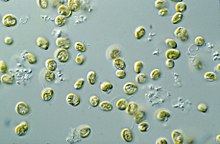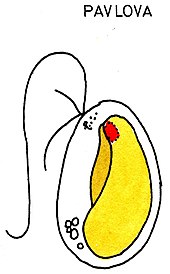
Back بفلوفية Arabic Pavlovophyceae BS Pavlovales Spanish Pavlovaceae Croatian Pavlovaceae Hungarian 파블로바과 Korean
| Pavlovaceae | |
|---|---|

| |
| Pavlova sp. | |
| Scientific classification | |
| Domain: | Eukaryota |
| Clade: | Diaphoretickes |
| Phylum: | Haptista |
| Subphylum: | Haptophytina J. C. Green & L. K. Medlin, 2000 |
| Class: | Pavlovophyceae |
| Order: | Pavlovales J. C. Green |
| Family: | Pavlovaceae J. C. Green |
| Genera | |
| Synonyms | |
| |
Pavlovaceae is a family of haptophytes. It is the only family in the order Pavlovales, which is the only order in the class Pavlovophyceae.[1] It contains four genera, Diacronema, Exanthemachrysis, Pavlova and Rebecca.[2]
Pavlovophyceae haptophytes also reportedly store photosynthetic carbon in paramylon polysaccharide granules (with a crystalline microfibrillar structure),[3] unlike the chrysolaminarin used as the polysacharide storage form by most haptophytes.[4][5]
- ^ Bendif, El Mahdi; Probert, Ian; Hervé, Annie; Billard, Chantal; Goux, Didier; Lelong, Christophe; Cadoret, Jean-Paul; Véron, Benoît (2011-11-01). "Integrative Taxonomy of the Pavlovophyceae (Haptophyta): A Reassessment". Protist. 162 (5): 738–761. doi:10.1016/j.protis.2011.05.001. PMID 21715228.
- ^ Guiry, M.D.; Guiry, G.M. "Pavlovaceae". AlgaeBase. World-wide electronic publication, National University of Ireland, Galway.
- ^ Bendif, El Mahdi; Probert, Ian; Hervé, Annie; Billard, Chantal; Goux, Didier; Lelong, Christophe; Cadoret, Jean-Paul; Véron, Benoît (2011). "Integrative Taxonomy of the Pavlovophyceae (Haptophyta): A Reassessment". Protist. 162 (5): 738–761. doi:10.1016/j.protis.2011.05.001.
- ^ Tsuji, Yoshinori; Yoshida, Masaki (2017). "Biology of Haptophytes: Complicated Cellular Processes Driving the Global Carbon Cycle". Advances in Botanical Research. Vol. 84. Elsevier. p. 219–261. doi:10.1016/bs.abr.2017.07.002. ISBN 978-0-12-802651-9.
- ^ Penot, Mathias; Dacks, Joel B.; Read, Betsy; Dorrell, Richard G. (2022-12-31). "Genomic and meta-genomic insights into the functions, diversity and global distribution of haptophyte algae". Applied Phycology. 3 (1): 340–359. doi:10.1080/26388081.2022.2103732. ISSN 2638-8081.
